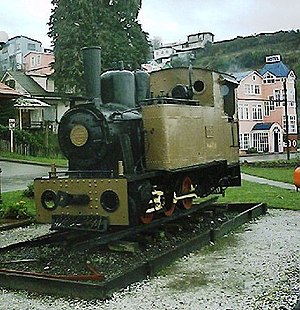Ferrocarril de Chiloe
| Ferrocarril de Chiloe | |||||||||||||||||||||||||||||||||||||||||||||||||||||
|---|---|---|---|---|---|---|---|---|---|---|---|---|---|---|---|---|---|---|---|---|---|---|---|---|---|---|---|---|---|---|---|---|---|---|---|---|---|---|---|---|---|---|---|---|---|---|---|---|---|---|---|---|---|
|
Planning of the route and elevation profile around 1909
| |||||||||||||||||||||||||||||||||||||||||||||||||||||
| Route length: | 88.4 + 8.4 = 96.8 km | ||||||||||||||||||||||||||||||||||||||||||||||||||||
| Gauge : | 600 mm ( narrow gauge ) | ||||||||||||||||||||||||||||||||||||||||||||||||||||
|
|||||||||||||||||||||||||||||||||||||||||||||||||||||
The Ferrocarril de Chiloé was a 1912-1960 operated narrow-gauge railway with a gauge of 600 mm on the Chilean Isla Grande de Chiloé between the cities of Castro and Ancud with a branch to the pier of Lechagua used for goods traffic.
history
Planning and construction
Before the construction of the narrow-gauge railway, the only land transport route between Ancud and Castro, the two most important cities on the island, was via the old Caicumeo Road, which was built at the end of the 18th century.
Building a railway on Chiloé was proposed in 1899 by the then Senator Ramón Rozas. However, the idea was discarded for economic reasons.
In 1905 the Chilean congress commissioned the first studies and in 1907 the Franco-Belgian consortium Societe Chemin de Fer du Chili was commissioned to conduct a detailed study. Work on this project finally began on February 6, 1909 with a ceremony in the future Ancud train station. The construction took three years and the railway was finally inaugurated on April 2, 1912. The network consisted of the 88.4-kilometer stretch between Ancud and Castro and the 8.4-kilometer branch between Ancud and Lechagua. Scheduled operations began on July 27, 1912.
business
In the early years, the journey between Ancud and Castro took five hours. There were frequent derailments due to a lack of experience.
To overcome the geographical features of the island, three bridges (San Antonio, Puntra and Butalcura) and fifteen viaducts had to be built. The branch line to Lechagua was also connected with the construction of a 152 m long pier, which was intended as the starting point for a large port city in this area.
Over the years, the Piruquina, Llau-Llau and Ten-Ten stops have been added. The original plan also included the future expansion of the road to Quellón and the construction of a junction from Mocopulli to Dalcahue. However, the economic problems in operation made these projects impossible, so they were never realized.
Decline
The railway line was badly hit during the Valdivia earthquake in 1960 . Part of the route sank under water and several of the bridges were destroyed, making further operation impossible. Likewise, the growth in road traffic made rebuilding the railroad unprofitable, so it was shut down after the earthquake.
Conservation and monument protection
In 2008 the documentary El Camahueto de Hierro was made, which thematizes the history of this railway.
On August 24, 2016, the National Monuments Council approved an application for the declaration of a national monument for a group of railway goods belonging to the disused Ferrocarril de Chiloé. These are the former train station at Ancud, the Butalcura Bridge in Dalcahue and the number 5057 locomotive in Castro.
Historical photos
Individual evidence
- ^ Railways of the Far South: A Chilote line.
- ↑ a b c d Ferrocarriles en el Cono Sur: Una línea en Chiloé . December 23, 2011.
- ↑ a b c Luis Mansilla Vidal: Relación genealógica de varias familias de Chiloé. Angol: Imprenta El Colono. 1914. pp. 18-22
- ↑ Amigos del Tren: El camahueto de hierro . (Video)
- ↑ Vestigios del tren en Chiloé a punto de ser declarados Monumento Nacional. SoyChiloé. August 25, 2016.











